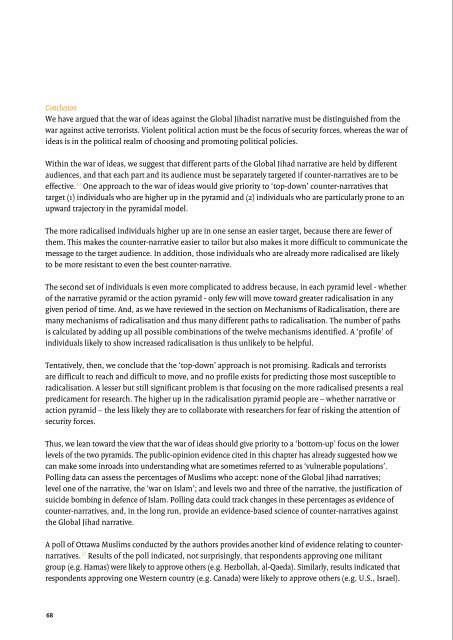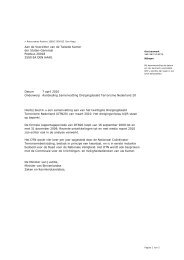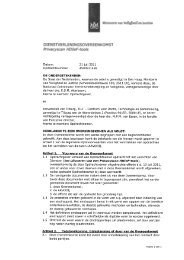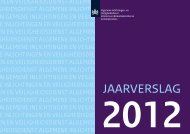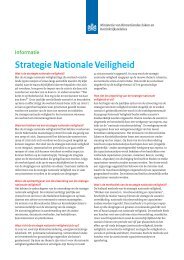Countering Violent Extremist Narratives
Countering Violent Extremist Narratives
Countering Violent Extremist Narratives
- No tags were found...
Create successful ePaper yourself
Turn your PDF publications into a flip-book with our unique Google optimized e-Paper software.
ConclusionWe have argued that the war of ideas against the Global Jihadist narrative must be distinguished from thewar against active terrorists. <strong>Violent</strong> political action must be the focus of security forces, whereas the war ofideas is in the political realm of choosing and promoting political policies.Within the war of ideas, we suggest that different parts of the Global Jihad narrative are held by differentaudiences, and that each part and its audience must be separately targeted if counter-narratives are to beeffective. 17 One approach to the war of ideas would give priority to ‘top-down’ counter-narratives thattarget (1) individuals who are higher up in the pyramid and (2) individuals who are particularly prone to anupward trajectory in the pyramidal model.The more radicalised individuals higher up are in one sense an easier target, because there are fewer ofthem. This makes the counter-narrative easier to tailor but also makes it more difficult to communicate themessage to the target audience. In addition, those individuals who are already more radicalised are likelyto be more resistant to even the best counter-narrative.The second set of individuals is even more complicated to address because, in each pyramid level - whetherof the narrative pyramid or the action pyramid - only few will move toward greater radicalisation in anygiven period of time. And, as we have reviewed in the section on Mechanisms of Radicalisation, there aremany mechanisms of radicalisation and thus many different paths to radicalisation. The number of pathsis calculated by adding up all possible combinations of the twelve mechanisms identified. A ‘profile’ ofindividuals likely to show increased radicalisation is thus unlikely to be helpful.Tentatively, then, we conclude that the ‘top-down’ approach is not promising. Radicals and terroristsare difficult to reach and difficult to move, and no profile exists for predicting those most susceptible toradicalisation. A lesser but still significant problem is that focusing on the more radicalised presents a realpredicament for research. The higher up in the radicalisation pyramid people are – whether narrative oraction pyramid – the less likely they are to collaborate with researchers for fear of risking the attention ofsecurity forces.Thus, we lean toward the view that the war of ideas should give priority to a ‘bottom-up’ focus on the lowerlevels of the two pyramids. The public-opinion evidence cited in this chapter has already suggested how wecan make some inroads into understanding what are sometimes referred to as ‘vulnerable populations’.Polling data can assess the percentages of Muslims who accept: none of the Global Jihad narratives;level one of the narrative, the ‘war on Islam’; and levels two and three of the narrative, the justification ofsuicide bombing in defence of Islam. Polling data could track changes in these percentages as evidence ofcounter-narratives, and, in the long run, provide an evidence-based science of counter-narratives againstthe Global Jihad narrative.A poll of Ottawa Muslims conducted by the authors provides another kind of evidence relating to counternarratives.17 Results of the poll indicated, not surprisingly, that respondents approving one militantgroup (e.g. Hamas) were likely to approve others (e.g. Hezbollah, al-Qaeda). Similarly, results indicated thatrespondents approving one Western country (e.g. Canada) were likely to approve others (e.g. U.S., Israel).More surprising was the fact that approval of militant groups was unrelated to approval of Western countries.Approval of Hamas was not related to disapproval of Israel, for instance.If replicated for other populations of Muslims, these results would have significant implications forcountering the Global Jihad narrative. It seems that we cannot count on turning Muslims against Islamicmilitants via counter-narratives that help Muslims feel more positive toward the West. Similarly, perhapswe cannot count on making Muslims more positive toward the West by turning them against Islamicmilitants. Although it is easy to assume that Muslims must choose between Islamic militants and the West,our results suggest that the war of ideas against the Global Jihad narrative must have two separate andindependent targets: moving Muslims against militants and moving Muslims toward the West.Finally, it is important to raise another kind of difficulty with counter-narratives, no matter whether thetarget is top-down or bottom-up. The danger is that a message may be effective with the target audiencebut have unintended consequences for those not immediately targeted. In this, counter-narratives aresimilar to more kinetic forms of counterinsurgency: both can have collateral damage that underminespolitical goals. For instance, a message arguing that Islam does not approve killing enemy civilians mightcombat acceptance of suicide bombing in defence of Islam, but might at the same time reinforce, at leastimplicitly, that Western countries are enemies engaged in war against Islam.In the end, the danger with counter-narratives is what the military refers to as a ‘ready-fire-aim’ problem: Wethink we know the source of the problem when, in fact, the issue is much more complex and differentiatedthan it appears. Although a well-intentioned solution, it may either risk diffusing scarce resources withouta measurable effect or spawning unintended consequences. The good news is that, in the marketplace ofideas, democracy’s mantra of non-violence to settle political disputes appears to have the upper hand. Thebad news is that democracies have not cornered the market yet.1 This research was supported by the United States Department ofHomeland Security through the National Consortium for theStudy of Terrorism and Responses to Terrorism (START), grantnumber N00140510629. However, any opinions, findings, andconclusions or recommendations in this document are thoseof the authors and do not necessarily reflect views of the U.S.Department of Homeland Security.2 D. Betz, ‘The virtual dimension of contemporary insurgency andcounterinsurgency’, Small Wars and Insurgencies, vol. 19, no. 4,2008, p. 520.3 C. McCauley & S. Moskalenko, ‘Mechanisms of PoliticalRadicalization: Pathways Toward Terrorism’, Terrorism andPolitical Violence, vol. 20, no. 3, 2008, pp. 415-33.4 See for example Sageman, Leaderless Jihad, Philadelphia,University of Pennsylvania Press, 2007.5 N. Glick Schiller, L. Basch & C. Blanc-Szanton, Towards a TransnationalPerspective on Migration: Race, Class, Ethnicity, and NationalismReconsidered, New York Academy of Sciences, New York, 1992,p. 1. See also P. Bobbitt, The Shield of Achilles: War, Peace, and theCourse of History, Alfred A. Knopf, New York, 2002.6 The Counterpoint and the Demos reports examine the differenttriggers that might account for a turn to violence as opposed toa radical or fundamentalist outlook that remained non-violent.Both reports are forthcoming.7 Cf. E. Takáts, ‘A Theory of “Crying Wolf”: The Economics ofMoney Laundering Enforcement’, Journal of Law, Economics, andOrganization Advance Access, 13 August 2009.8 See for example S. Bux, ‘Muslim Youths, Islam and <strong>Violent</strong>Radicalization: Addressing Some Myths’, The Police Journal, no.80, 2007, pp. 267-78; T. Hegghammer, ‘Terrorist recruitment andradicalization in Saudi Arabia’, Middle East Policy, vol. 13, no. 4,2006, pp. 39-60; J. Horgan, ‘From profiles to pathways and rootsto routes: Perspectives from psychology on radicalization intoterrorism’, The Annals of the American Academy of Political and SocialScience, no. 116, 2008, pp. 80-94; A. Kirby, ‘The London bombersas self-starters: A case study in indigenous radicalization and theemergence of autonomous cliques’, Studies in Conflict & Terrorism,vol. 30, no. 5, 2007, pp. 415-28; E.F. Kohlmann, ‘Homegrownterrorists: Theory and cases in the war on terror’s newest front’,The Annals of the American Academy of Political and Social Science, no. 618,2008, pp.95-109; and McCauley & Moskalenko.68 69


